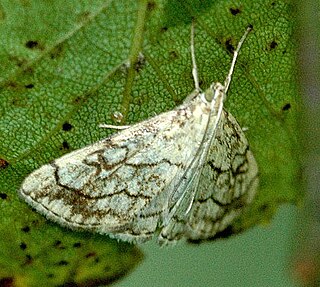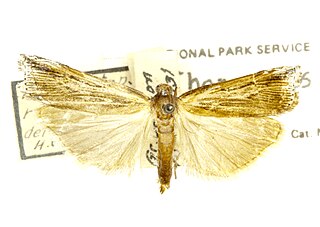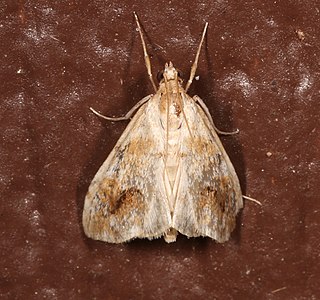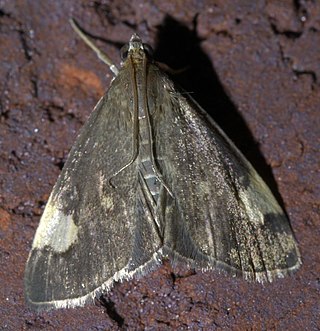
Augustus Radcliffe Grote was a British entomologist who described over 1,000 species of butterflies and moths. He is best known for his work on North American Noctuidae. A number of species were named after him, including the moth Horama grotei.

Evergestinae is a fairly small subfamily of the lepidopteran family Crambidae, the crambid snout moths. The subfamily was described by H. Marion in 1952. It contains roughly 140 species on all continents and continental islands. Evergestine moths resemble Pyraustinae; however, the male genitalia have a long uncus and long, slender gnathos. The larvae feed mostly on Brassicaceae.

Evergestis is a genus of moths of the family Crambidae described by Jacob Hübner in 1825. A number of species are pests, including the cross-striped cabbageworm, a pest of cole crops such as cabbage.
Agriphila anceps is a moth in the family Crambidae. It was described by Augustus Radcliffe Grote in 1880. It is found in North America, where it has been recorded from California.
Agriphila attenuata is a moth in the family Crambidae. It was described by Augustus Radcliffe Grote in 1880. It is found in North America, where it has been recorded from coastal California, Washington, Wyoming, British Columbia and Alberta. The habitat consists of grasslands.
Crambus occidentalis is a moth in the family Crambidae. It was described by Augustus Radcliffe Grote in 1880. It is found in North America, where it has been recorded from Alberta and California.
Pediasia laciniella is a moth in the family Crambidae. It was described by Augustus Radcliffe Grote in 1880. It is found in North America, where it has been recorded from Alberta, California, Illinois, Maine, Michigan, Quebec and Virginia.
Thaumatopsis edonis is a moth in the family Crambidae. It was described by Augustus Radcliffe Grote in 1880. It is found in North America, where it has been recorded from Florida, Kentucky, Maine, Massachusetts, Mississippi, Missouri, Nebraska, New Jersey, Oklahoma and South Carolina. It is listed as threatened in the US state of Connecticut.

Thaumatopsis repandus is a moth in the family Crambidae. It was described by Augustus Radcliffe Grote in 1880. It is found in North America, where it has been recorded from Arizona, British Columbia, California, Colorado, New Mexico, Oregon and Washington.
Evergestis aridalis is a moth in the family Crambidae. It was described by William Barnes and James Halliday McDunnough in 1914. It is found in North America, where it has been recorded from California and Nevada.
Evergestis borregalis is a moth in the family Crambidae. It was described by Eugene G. Munroe in 1974. It is found in North America, where it has been recorded from California and New Mexico.
Evergestis eurekalis is a moth in the family Crambidae. It was described by William Barnes and James Halliday McDunnough in 1914. It is found in North America, where it has been recorded from Arizona, California and Utah.
Evergestis funalis is a moth in the family Crambidae. It was described by Augustus Radcliffe Grote in 1878. It is found in North America, where it has been recorded from Alaska, Arizona, British Columbia, California, Colorado, Nevada, Oregon, Utah and Washington.

Evergestis lunulalis is a moth in the family Crambidae. It was described by William Barnes and James Halliday McDunnough in 1914. It is found in North America, where it has been recorded from Arizona, New Mexico and Texas.
Evergestis nolentis is a moth in the family Crambidae. It was described by Carl Heinrich in 1940. It is found in North America, where it has been recorded from California.
Evergestis obliqualis is a moth in the family Crambidae. It was described by Augustus Radcliffe Grote in 1883. It is found in North America, where it has been recorded from Arizona, California, Colorado, New Mexico, Texas and Utah.
Evergestis subterminalis is a moth in the family Crambidae. It was described by William Barnes and James Halliday McDunnough in 1914. It is found in western North America, where it has been recorded from west central Alberta south to Colorado, Utah and California. The habitat consists of montane meadows.
Evergestis triangulalis is a moth in the family Crambidae. It was described by William Barnes and James Halliday McDunnough in 1914. It is found in North America, where it has been recorded from Arizona, Nevada and New Mexico.

Evergestis unimacula, the large-spotted evergestis moth, is a moth in the family Crambidae. It was described by Augustus Radcliffe Grote and Coleman Townsend Robinson in 1867. It is found in North America, where it has been recorded from Georgia, Illinois, Indiana, Iowa, Maryland, Michigan, North Carolina, Ohio, Oklahoma, Ontario, Pennsylvania, Quebec, Tennessee and West Virginia. Outliers have been recorded from Florida.
Evergestis vinctalis is a moth in the family Crambidae. It was described by William Barnes and James Halliday McDunnough in 1914. It is found in North America, where it has been recorded from Alberta, Arizona, British Columbia, California, Colorado, Kansas, Montana, Nevada, New Mexico, Texas and Wyoming.





